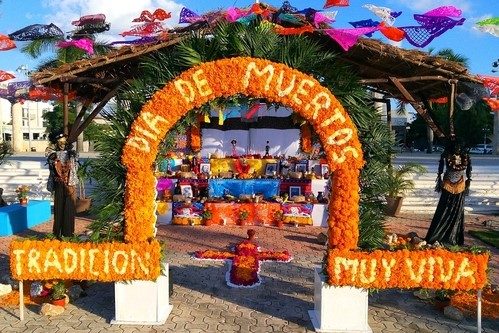Dia de los Muertos is a time for celebrating family and remembering ancestors. It’s a special celebration, rich with history and cultural significance. The ofrenda, or altar, is decorated with flowers, photos, and candles to honor the memory of those who have passed on. There are many important traditions in this celebration, but here are a few things to note about the flowers typically used in Dia de los Muertos altars.
What flowers are typically used on Day of the Dead altars?
Among the number of Dia de los Muertos flowers customarily used in the tradition, the most well-known is the marigold, also called the cempasúchil. Marigolds are circular flowers with layered, bowl-shaped petals that come in various shades of yellow, orange, and red. Any variety, or a mix of varieties, can be seen on Dia de los Muertos, but the most traditional variety is the Aztec marigold. This variety has larger, more spectacular flowers and grows much taller than other varieties. Their longer stems make them excellent to use as cut flowers, while the larger blooms provide more and larger petals for scattering.
Another flower that is sometimes included is chrysanthemums. Unlike marigolds, there is no particular variety of chrysanthemum associated with the holiday, but there is a color. White chrysanthemums specifically are used, while other colors are not.
However, any color of gladiolus is acceptable. These flowers grow on tall stems shaped like spikes or swords and come in a wide array of colors. This makes them excellent accent flowers! Purple gladiolus are especially striking when paired with the bright golds of marigold, while a pink gladiolus softens the arrangement.
What is the significance of these flowers?
The use of marigold in Dia de los Muertos stretches all the way back to the Aztecs. To the Aztecs, marigolds were a sacred flower, representative of the gods, and were cultivated to produce bigger, brighter blooms. That’s right, the name Aztec marigold isn’t just for show, they were bred by the Aztecs! They used the flowers in ceremonies to honor the gods and their ancestors, which eventually mixed with Catholicism and evolved into Dia de los Muertos. Today, they are used in decorating so that their bright color and strong scent can help lead the spirits of ancestors to their families for a day of reunion.
Chrysanthemums are considered funeral flowers in several cultures, even though some of those cultures have little connection to each other. Regardless of why chrysanthemums have become so widely associated with death, white chrysanthemums in particular have come to represent a celebration of the dead. They are sometimes used in Dia de los Muertos decorations to celebrate the lives of ancestors and loved ones who have passed on.
Gladiolus symbolism is not quite as universal as that of chrysanthemums. With their bright colors and sword-like shape, there are myriad meanings for this plant. In the case of Dia de los Muertos, they typically represent remembrance.
What else might be placed on an ofrenda?
The ofrenda itself is typically a table, covered with a white tablecloth that is decorated with cut paper and flowers. An ofrenda is personal and unique to each family, so it’s impossible to list every single thing that may appear on one. There are, however, a few common items included in an ofrenda. One such item is pictures of loved ones who have passed. These are accompanied by candles, lit in remembrance, honor, and to guide their spirit to the ofrenda.
Food is placed before the pictures. The food may be a variety of traditional dishes, fruits, and pan de muerto. A particular favorite food of a loved one is often included.
Mementos of loved ones, such as clothing items, toys, or anything strongly associated with a particular person may be set on the ofrenda, as well. Religious items, like crosses or saint’s candles, are also often included. If the ofrenda has multiple layers or levels, the religious items may be at the top, but they can also be spread throughout the other layers. Crosses made of flowers make a particularly beautiful touch.
Dia de los Muertos is a time for celebrating and taking pride in family. Traditions can vary from place to place or family to family, but what stays the same is the love for your family and heritage. Remembering loved ones can take many forms, so it’s important to stay true to yourself, and enjoy Dia de los Muertos in the way that most speaks to you.



